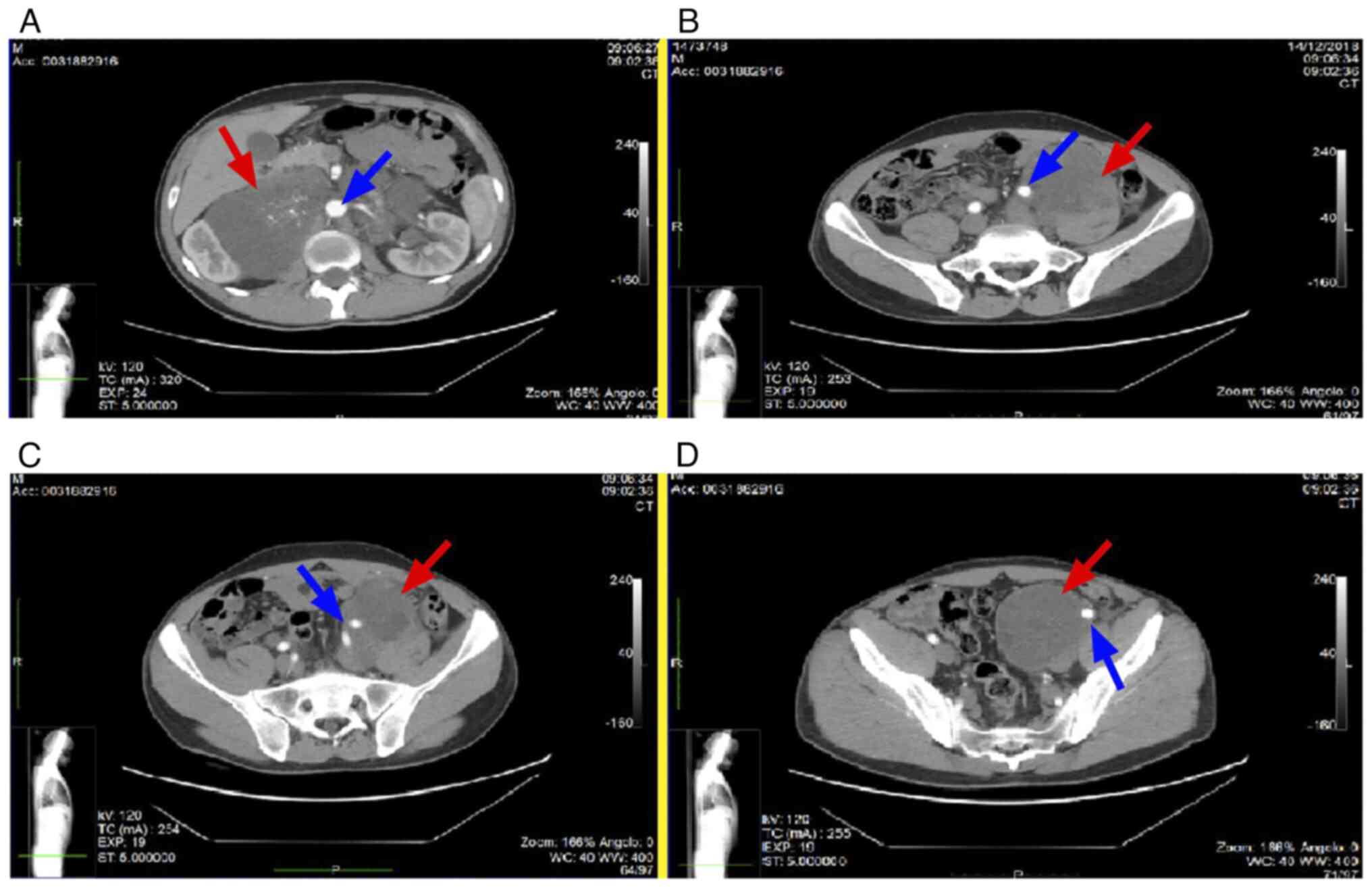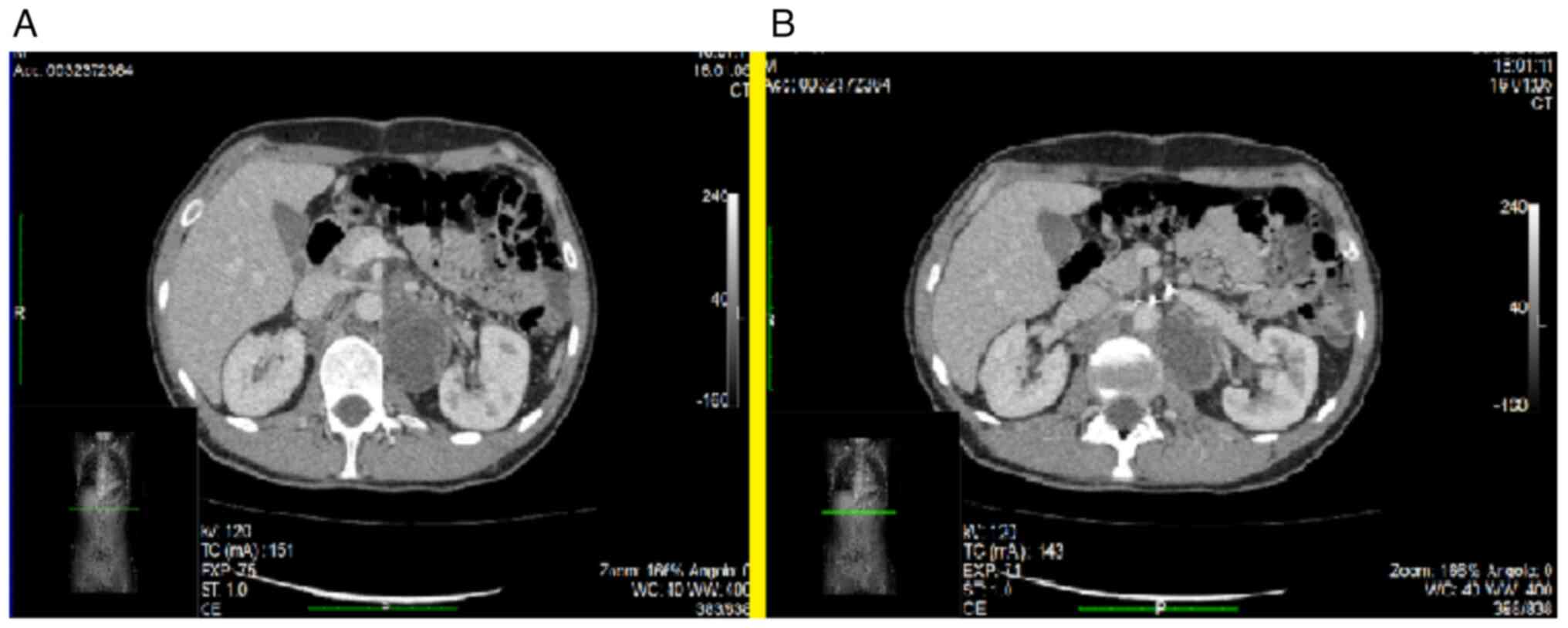|
1
|
Bosl GJ and Motzer NJ: Testicular
germ-cell cancer. N Engl J Med. 337:242–253. 1997.PubMed/NCBI View Article : Google Scholar
|
|
2
|
Cole WH and Everson TC: Spontaneous
regression of cancer preliminary report. Ann Surg. 144:366–383.
1956.PubMed/NCBI View Article : Google Scholar
|
|
3
|
Looijenga LH and Oosterhuis JW:
Pathogenesis of testicular germ cell tumors. Rev Reprod. 4:90–100.
1999.PubMed/NCBI View Article : Google Scholar
|
|
4
|
Salman T: Spontaneous tumor regression. J
Oncol Sci. 2:1–4. 2016.
|
|
5
|
Johnson K and Brunet B: Brain metastases
as presenting feature in ‘burned out’ testicular germ cell tumor.
Cureus. 8(e551)2016.PubMed/NCBI View Article : Google Scholar
|
|
6
|
Fabre E, Jira H, Izard V, Ferlicot S,
Hammoudi Y, Theodore C, Di Palma M, Benoit G and Droupy S:
‘Burned-out’ primary testicular cancer. BJU Int. 94:74–78.
2004.PubMed/NCBI View Article : Google Scholar
|
|
7
|
Cancer incidence in five continents, vol
VIII. IARC Sci Publ. 155:1–781. 2002.PubMed/NCBI
|
|
8
|
Huyghe E, Matsuda T and Thonneau P:
Increasing incidence of testicular cancer worldwide: A review. J
Urol. 170:5–11. 2003.PubMed/NCBI View Article : Google Scholar
|
|
9
|
Surveillance, Epidemiology and End Result
Program (SEER): Cancer Stat Facts: Testicular Cancer. National
Cancer Institute, Bethesda, MD, 2015. https://seer.cancer.gov/statfacts/html/testis.html.
|
|
10
|
Calvo OA, Rodríguez Alonso A, Pérez García
D, Domínguez Freire F, Alonso Rodrigo A, Rodríguez Iglesias B,
Benavente Delgado J, Barros Rodríguez JM, Fiaño Valverde C and
Nogueira March JL: Extragonadal germ cell tumor with ‘burned-out’
phenomenon in the testis. Actas Urol Esp. 23:880–884.
1999.PubMed/NCBI View Article : Google Scholar
|
|
11
|
Ulbright T, Amin M, Balzer B, et al:
Tumors of the testis and paratesticular tissue. In: WHO
Classification of Tumors of the Urinary System and Male Genital
Organs. Moch H, Humphrey PA, Ulbright TM and Reuter VE (eds). 4th
edition. Lyon: IARC Press, pp185-258, 2016.
|
|
12
|
Astigueta JC, Abad-Licham MA, Agreda FM,
Leiva BA and De la Cruz JL: Spontaneous testicular tumor
regression: Case report and historical review.
Ecancermedicalscience. 12(888)2018.PubMed/NCBI View Article : Google Scholar
|
|
13
|
Prym P: Spontanheilung eines bosartigen,
wahrscheinlich chorionephiteliomatosen Gewachses im Hoden. Virchows
Arch Pathol Anat. 265:239–258. 1927.
|
|
14
|
Azzopardi JG, Mostofi FK and Theiss EA:
Lesions of testes observed in certain patients with widespread
choriocarcinoma and related tumors. The significance and genesis of
hematoxylin-staining bodies in the human testis. Am J Pathol.
38:207–225. 1961.PubMed/NCBI
|
|
15
|
Comiter CV, Renshaw AA, Benson CB and
Loughlin KR: Burned-out primary testicular cancer: Sonographic and
pathological characteristics. J Urol. 156:85–88. 1996.PubMed/NCBI
|
|
16
|
Balzer BL and Ulbright TM: Spontaneous
regression of testicular germ cell tumors: An analysis of 42 cases.
Am J SurgPathol. 30:858–865. 2006.PubMed/NCBI View Article : Google Scholar
|
|
17
|
Extramiana J, De La Rosa F, Madero S,
Tagarro D, Díaz González R, Martínez M, Gandía V, Leiva O and
Borobia V: ‘Burned-out’ testicular tumor. Actas Urol Esp.
10:289–294. 1986.PubMed/NCBI(In Spanish).
|
|
18
|
Angulo JC, González J, Rodríguez N,
Hernández E, Núñez C, Rodríguez-Barbero JM, Santana A and López JI:
Clinicopathological study of regressed testicular tumors (apparent
extragonadal germ cell neoplasms). J Urol. 182:2303–2310.
2009.PubMed/NCBI View Article : Google Scholar
|
|
19
|
López JI and Angulo JC: Burned-out tumor
of the testis presenting as Retroperitoneal choriocarcinoma. Int
Urol Nephrol. 26:549–553. 1994.PubMed/NCBI View Article : Google Scholar
|
|
20
|
Tejido Sánchez A, Villacampa Aubá F,
Martín Muñoz MP, Rosino Sánchez A, Cruceyra Betriu G, Martínez
Silva V and Leiva Galvis O: Burned-out testicular tumor. Arch Esp
Urol. 53:447–452. 2000.PubMed/NCBI(In Spanish).
|
|
21
|
Mosillo C, Scagnoli S, Pomati G,
Caponnetto S, Mancini ML, Bezzi M, Cortesi E and Gelibter A:
Burned-Out testicular cancer: Really a different history. Case Rep
Oncol. 10:846–850. 2017.PubMed/NCBI View Article : Google Scholar
|
|
22
|
Simpson AH, Calvert DG and Codling BW: The
shrinking semonima. J R Soc Med. 83(187)1990.PubMed/NCBI
|
|
23
|
Naseem S, Azzopardi A, Shrotri N and Mufti
GR: The shrinking seminoma-fact or fiction? Urol Int. 65:208–210.
2000.PubMed/NCBI View Article : Google Scholar
|
|
24
|
Yucel M, Kabay S, Saracoglu U, Yalcinkaya
S, Hatipoglu NK and Aras E: Burned-out testis tumor that
metastasized to retroperitoneal lymph nodes: A case report. J Med
Case Rep. 3(7266)2009.PubMed/NCBI View Article : Google Scholar
|
|
25
|
Kreydin EI, Barrisford GW, Feldman AS and
Preston MA: Testicular cancer: What the radiologist needs to know.
AJR Am J Roentgenol. 200:1215–1225. 2013.PubMed/NCBI View Article : Google Scholar
|
|
26
|
Mola Arizo MJ, Gonzalvo Perez V,
Torregrosa Maicas MD, Navarro Anton JA, Gomez-Ferrer Lozano A,
Estany Perez A and Polo Peris AC: Burn out bilateral testicular
tumor. Actas Urol Esp. 29:318–321. 2005.PubMed/NCBI(In Spanish).
|
|
27
|
Gomez Parada J and Puyol Pallas M: Occult
primary testicular tumor or burnt testicular tumor. Apropos of a
case. Arch Esp Urol. 49:635–638. 1996.PubMed/NCBI(In Spanish).
|
|
28
|
Kontos S, Doumanis G, Karagianni M,
Politis V, Simaioforidis V, Kachrilas S and Koritsiadis S:
Burned-out testicular tumor with retroperitoneal lymph node
metastasis: A case report. J Med Case Rep. 3(8705)2009.PubMed/NCBI View Article : Google Scholar
|

















